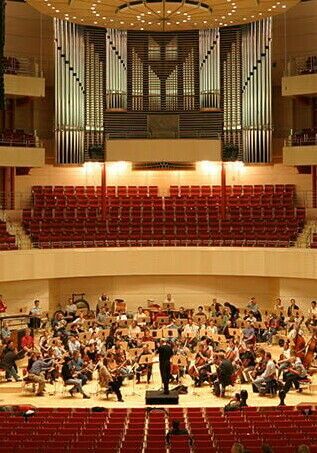Saalbau Essen, built in the mid-19th century, is home to the Philharmonie Essen in western Germany, and has recently teamed up with L-Acoustics to bring high-quality, modern audio to its concerts that now span multiple genres.
The concert hall is renowned for its acoustics, after much modernising and renovation to a building which was partly destroyed during World War II. Some 72 million Euros have been spent on the 2003 and 2004 work, which saw the Alfried-Krupp-Saal concert hall extend to a 2,000-person capacity.
From 2019 onwards, the hall’s programme began diversifying from just classical music, and the venue’s management began exploring the possibility of a new audio system that could handle rock, jazz and pop concerts. Following a project of acoustic renovations, the team settled on an L-Acoustics installation centring around the Kara II system.
“The previous system had worked very well, but with the evolving music programme, there was a need for a little more power,” said Müller-BBM’s Harald Frisch, who planned and designed the hall’s previous system and is now responsible for its current loudspeaker and electroacoustic design.
“We knew the room acoustics very well. We even had the models from the first planning, which we used to check to confirm if they were still as close to reality as possible before planning the new loudspeaker system.”
Frisch and his team decided to organise a blind loudspeaker test with an audience of around 20 people, using an L-Acoustics system and two systems of competitors.
With the original system being self-powered, two separate technical specifications were drawn up for the new system, one self-powered and one using external amplifiers. When costs were compared, it was discovered that L-Acoustics was the best choice for audio quality and more cost-effective.
Müller-BBM had to address the challenge of the venue’s side galleries which had not been adequately covered with the previous system.
“To address this, we used larger arrays for the side galleries rather than delays,” Frisch said. “While delays may be the usual choice, it has the unhappy side-effect of localising sound away from the stage for the gallery audiences. We wanted to have a sound source coming from the stage that was strong enough to reach the galleries and localise sound from the stage, no matter where the audience is seated.”
With the Alfried-Krupp-Saal primarily being a concert hall for classical music, all arrays needed to be raised up to the roof during classical concerts, making the sound reinforcement system invisible. “This created some rigging and cabling challenges to solve,” Frisch said, but the benefits were worth the effort.
“We also included a delay line for the gallery opposite the stage to prevent late reflections from the rear wall. With the new system, the main balcony on the opposite side of the stage only gets a little impulse from the main system to create an acoustical localisation towards the stage. A powerful delay system is installed to fully cover the balcony with proper sound pressure level.”
The new Kara II-based system was supplied, installed, and commissioned by Amptown System Company GmbH, an L-Acoustics Certified Partner Integrator in Germany. Amptown project manager, Michael Klötzer, explained that “the basic design was done by Martin Rode, senior application project engineer at L-Acoustics, who collaborated with the Müller-BBM team to achieve the final outcome.”
“Part of the specification was to improve the coverage in the upper balcony, which was always tricky with the old system,” Rode said.
“Since the horizontal dispersion of Kara II is adjustable, it’s possible to tune that to the shape of the room. We set the upper cabinets in the main arrays to 90 degrees, and that gave us a great result. This is unique to Kara II, and it’s given us much greater clarity than other systems can achieve.”
The audience area is covered by left/centre/right arrays of Kara II arrays comprising 12 cabinets left and right, with eight Kara II in the centre. Four KS21 subs per side in cardioid configuration provide low-frequency energy at each side of the stage with nine compact 5XT spread across the stage lip to provide front-fill while keeping sight lines clear. A pair of A10 (one Wide, one Focus) sit atop the KS21, allowing the audience to localise vocal content at stage level.
The design throughout the hall is effectively a distributed system covering 360 degrees. Arrays of three Kara II cabinets per side cover the upper side balconies, once again using the adjustable dispersion — two of the enclosures are trimmed to a very narrow horizontal dispersion of 70 degrees while the lowest cabinet is set to 90 degrees to cover the middle balcony.
The choir balconies, above and behind the stage are served by four arrays of A10 Wide: the two inner arrays consisting of three A10 Wide and the two outer arrays counting one each of A10 Focus and Wide. Additionally, the rear balcony area behind the Kara II arrays is covered by an A10 Wide for the upper balcony and two A10 Wide per side for the lower balcony.
“Although the main system covered those areas, the additional speakers gave us a little more energy and a bit of freshness there,” Rode said.
Calibration was performed using a P1 Processor in combination with M1 software, and despite having up to 122 separate measurements to analyse, the process only took around two hours as the M1 measurement sequence handles up to four mics at the same time.
Rode said that the venue’s team are delighted with the homogeneity achieved. “The sound image is constant with the acoustic orientation always towards the stage. Regardless of where you are in the room, the sound image is always in the right place.”
“This is the first time in my career that I have replaced my own system and put in a new one,” Frisch concluded. “The results from the new L-Acoustics system are impressive and deliver the power, coverage, and clarity that Philharmonie Essen deserves."

